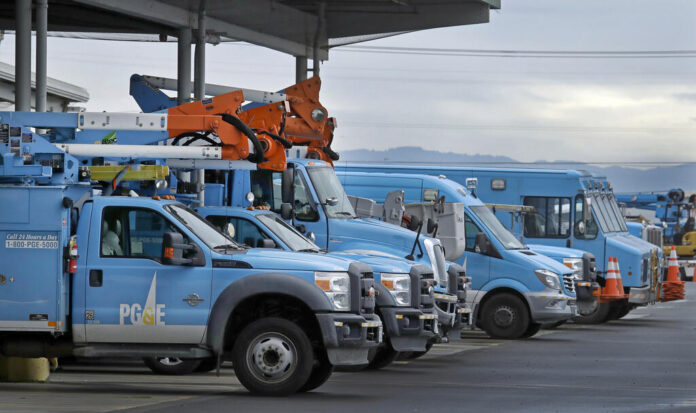
April 30, 2025
PG&E builds on risk-based safety measures that prevented major wildfires in 2023 and 2024
OAKLAND, Calif.— Building on proven layers of protection that ensured no major wildfires were caused by company equipment in 2023 and 2024 and infused with technological innovation, Pacific Gas and Electric Company (PG&E) today shared its robust, risk-informed strategy to continue that progress in the face of an ever-changing climate. PG&E’s 2026-2028 Wildfire Mitigation Plan (WMP), submitted to the California Office of Energy Infrastructure Security (Energy Security), details the company’s relentless efforts to build, maintain, and operate its systems to minimize the risk of catastrophic wildfires and keep its customers and communities safe. The plan fully integrates high-tech tools and solutions, including drone inspection of assets, the use of artificial intelligence to improve weather forecasts, and the installation of sophisticated sensors that can detect vibrations, sounds, and light that could indicate potential anomalies in an electrical circuit that could lead to ignition. PG&E’s WMP outlines critical layers of protection that together reduce the risk of wildfire ignition and strengthen PG&E’s electric grid in locations in Northern and Central California where the risk is most acute. These measures include reinforcing more than 700 miles of overhead power lines and poles, as well as removing lines and adding remote networks; putting nearly 1,100 more miles of power lines underground; using drones to obtain a bird’s-eye view of electric assets; leveraging a mature network of weather stations and high-definition AI-powered cameras; trimming trees, and more.
When wildfire risk is elevated, these efforts are reinforced with highly effective operational mitigations, such as Enhanced Powerline Safety Settings (EPSS) and Public Safety Power Shutoffs (PSPS) that protect customers. “Our system is safer today than it was yesterday and will be even safer tomorrow. Our Wildfire Mitigation Plan employs several layers of protection that we use to stop catastrophic wildfires in our communities. The combination of tools, technology, and the expertise of our colleagues works to mitigate risk, reduce fires, and prevent catastrophic wildfires,” says PG&E Executive Vice President of Operations and Chief Operating Officer Sumeet Singh.
“Our focus on improving the customer experience related to our wildfire mitigation efforts is unwavering,” Singh says. “We want a future where safe and reliable service is a reality, and we know our customers deserve it. We are working every day to make it possible.”
Technology for today and tomorrow
As capabilities such as wildfire cameras, weather stations, and our 24/7/365 Hazard Awareness & Warning Center (HAWC) mature and become more beneficial, PG&E continues to pursue innovative technologies in the wildfire space. For example, the utility is in the early stages of developing a real-time monitoring system to gain more dynamic insights into the status of electric assets, taking into account weather volatility.
WMP is introducing several new technology solutions that are being tested, evaluated, and, in some cases, implemented alongside proven wildfire risk reduction programs, including the following:
- Gridscope devices. The pilot implementation of Gridscope began in 2023 and extended to 2024, with more than 10,000 Gridscope devices now in use across 900 miles of circuit (or approximately 3.5% of the miles in areas with the highest fire risk). These pole-mounted sensors can detect vibrations, sounds, and light that may indicate potential anomalies and could lead to ignition. In July 2024, during a record-breaking heat wave, an electrical troubleshooter responding to a location identified by a Gridscope alert found burning vegetation on an energized line. The line was de-energized, preventing ignition and a potential wildfire. PG&E’s evaluation of the devices continues while considering a larger deployment. • Early Fault Detection (EFD). It’s like your car’s check engine light, but on the grid. Thanks to PG&E’s new radio frequency (RF) monitoring technology, a growing network of EFD sensors on power poles provides a comprehensive understanding of emerging equipment hazards, such as damaged conductors or vegetation encroachment, that would otherwise be difficult to detect. Promising early results led PG&E to consider expanding the deployment of advanced RF technology. These purposeful investments in technology could shift the paradigm of utility asset management.
- Aerial section inspections. This new inspection tool provides a clearer view of equipment risk in areas of extreme wildfire risk. Leveraging the aerial inspections in 2024 (220,000 poles) and 2025, span inspections will involve a review of a simplified, specialized set of photographs designed to identify equipment conditions that pose the greatest risk, including mid-span locations (between poles). These inspections will be conducted midway through the established three-year inspection cycle and will be tested between 2026 and 2028.
Proven Layers of Protection
WMP highlights layers of protection that have proven effective in reducing the risk of wildfire. Thanks to these tools, no major wildfires involving the company’s equipment occurred in 2023 and 2024.
- Burying power lines underground in high-fire risk areas is a permanent protection that reduces the risk of ignition of overhead electric distribution lines. PG&E plans to bury 1,077 miles of power lines between 2026 and 2028.
- Overhead system improvements, such as the installation of coated conductors, reinforced poles, and wider crossarms, will reduce the long-term ignition risk by improving grid construction and operation. The WMP provides for more than 700 miles of overhead reinforcement and the removal of lines with remote networks between 2026 and 2028.
- Enhanced Powerline Safety Settings protect 1.8 million PG&E customers who live and work in areas at high or extreme risk for wildfires. In 2024, these settings contributed to a more than 72% reduction in power outages reportable to the California Public Utilities Commission when enabled on primary distribution lines, compared to the 2018-2020 average. More than half of customers protected by EPSS did not experience any power outages while EPSS were enabled in 2024.
PG&E recognizes that outages on EPSS-enabled circuits, when they occur, are an inconvenience. Through the end of 2024, the average outage duration on an EPSS-enabled circuit decreased 17% compared to the average of the previous two years. PG&E will also install additional sectionalizing devices and animal and bird protection equipment to further reduce the impact of EPSS outages. Vegetation management programs continue to evolve, using a data-driven and risk-informed approach to reduce power outages and potential fires caused by vegetation contact with PG&E equipment.
Inspection and repair efforts are based on risk models and are part of comprehensive monitoring and data collection programs that provide insight into evolving environmental hazards around assets to inform mitigation actions.
Situational awareness enhancements include enabling artificial intelligence to process fire camera data and provide automated wildfire notifications. PG&E will continue to utilize the most advanced weather forecasts and a comprehensive monitoring and data collection network utilizing high-definition wildfire cameras and weather stations to detect, prevent, and respond to wildfire risk.
Public Safety Power Shutoffs are used as a last resort during extreme weather conditions to reduce the risk of catastrophic fires. PG&E’s expert meteorologists use cutting-edge weather models to forecast risk in a granular manner and account for vegetation in proximity to overhead power lines. In recent years, PG&E’s use of PSPS has evolved and been refined in terms of event size and duration. In 2023, three PSPS outages affected 5,000 customers. Due to more severe weather in 2024, PG&E initiated six PSPS events to protect 50,000 customers in 23 counties.
Media Note: Additional materials are available upon request.
About PG&E
Pacific Gas and Electric Company, a subsidiary of PG&E Corporation (NYSE: PCG), is a combined natural gas and electric utility serving more than 16 million people across 70,000 square miles in Northern and Central California. For more information, visit pge.com and pge.com/news.
–



